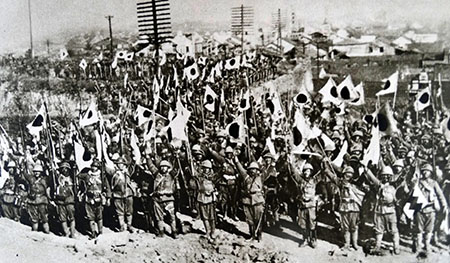Special to WorldTribune.com
The thunderclap came on an early Sunday morning. Amidst the idyllic and serene Pacific setting of Hawaii, Imperial Japan launched a surprise and devastating carrier-based air attack on the U.S. fleet moored at Pearl Harbor, outside Honolulu.
December 7, 1941 would be the date which would live in infamy for shocked and stunned Americans first hearing the news many times zones away from California to Colorado and Connecticut. The USA was now thrust into WWII by an attack few saw coming in the outlying territory of Hawaii.
Over 2,400 American servicemen, mostly U.S. Navy were killed that day; Twenty warships were sunk including the battleship USS Arizona. Four hundred aircraft were wrecked. The U.S. Pacific fleet was badly crippled but importantly not beaten.

Eighty years ago, WWII formally started for the United States.
Not so well known was that nearly simultaneously after the Pearl Harbor bombing, Japanese forces carried out a coordinated, daring and strategically stunning series of attacks on American bases in the Philippines, Guam and Wake Island as well as the invasion of British Malaya.
But let’s scroll back for a moment to a serious but oft-overlooked event of Dec. 7.
China was at war already for a decade as Tokyo set its sights to dismember Manchuria. Japan seized the industrial and strategic Chinese region and turned it into vassal state called Manchukuo.
Japan’s moves into Manchuria were greeted by deep concern and diplomatic pushback at the League of Nations in Geneva, but little else. Tokyo got away with it.
By 1937 Japanese forces would expand deeper into China; Peking, Shanghai and Nationalist China’s capital Nanking, which would become site of the infamous six-week atrocity of the Nanking Massacre. Still the war in China dragged on and the Imperial Japanese Army became bogged down.
Japan’s overreach on the China Mainland, and dogged resistance by the Nationalist Chinese forces, took their toll. By Summer 1941, the Roosevelt Administration slapped an American oil and steel Embargo on Japan which effectively shut off its petroleum jugular line necessary to Tokyo’s military machine. Japan faced a strategic conundrum; either halt offensive operations or break out and seize the oil resources in the Dutch East Indies.
Related — Pacific commander: ‘We’re watching largest military buildup’ since World War II, December 7, 2021
An attack and presumed knockout punch on the U.S. Pacific fleet moored at Pearl Harbor in far off Hawaii, became a serious military option and a near certainty.
Across the world, Europe was already in its second year of war since 1939 with the attack on Poland. France was occupied by the Nazis and Britain was under air attack. Hitler’s national socialist regime had already conquered much of Europe but was now facing military operations during its first Russian Winter.
But America remained on the sidelines no more. After the attack on Pearl Harbor, the USA was thrust into conflict. Nonetheless even in the lead up to war, the U.S. military was woefully unprepared. President Franklin D. Roosevelt favored a policy of strong rhetoric rather than proper military preparedness. Yet later what FDR called the “arsenal of Democracy” ensured the vast industrial and productive capacity of American industry could turn a peacetime consumer economy into a fearsome War machine. In Detroit, civilian auto production ended in 1941 and by 1942, the factories were turning out trucks and tanks.
Fast forward to more recent times. On September 11, 2001, the USA faced what I call the “Pearl Harbor Moment” of this generation. The seemingly endless “War on Terror” remains far from over but has largely neutralized the direct threat of Islamic extremism to the U.S.
Now again in East Asia, dark clouds gather as the People’s Republic of China flexes its political muscles, strengthened by a generation of trade and technology transfer from the U.S. which enhanced Beijing’s military capacity and its economic bottom line.
As with the world in the 1930’s the warning signs abound; Contemporary threats of communist China’s expansion in the South China Sea and it’s bullying of democratic Taiwan. All this comes amid the troubling backdrop of a declining U.S. Navy in size and strength.
Eighty years ago, Pearl Harbor became a jolting wake up call to the USA. Millions of Americans served in the military to turn the tide of Axis aggression both in Europe and the Pacific. One such man, Sen. Bob Dole (R-Kansas) was counted among the Greatest Generation. Soldier, Senator and Statesman, Bob Dole, who died at 98, was gravely wounded in Italy and carried that obvious burden throughout his amazing career in the Senate and a run for the Presidency. Sen. Dole always knew the price of freedom.
Few of his generation are still around to remember.
John J. Metzler is a United Nations correspondent covering diplomatic and defense issues. He is the author of Divided Dynamism the Diplomacy of Separated Nations: Germany, Korea, China (2014). [See pre-2011 Archives]

 By
By